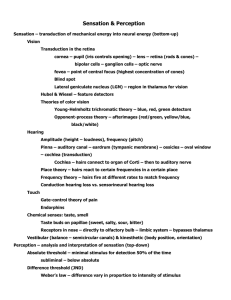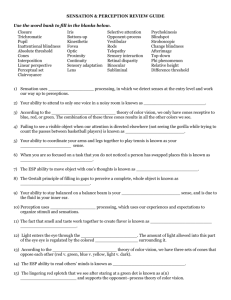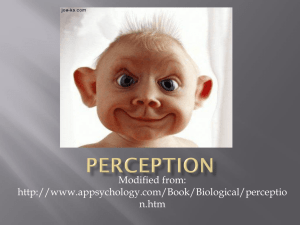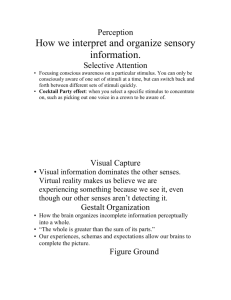Introduction to Sensation
advertisement
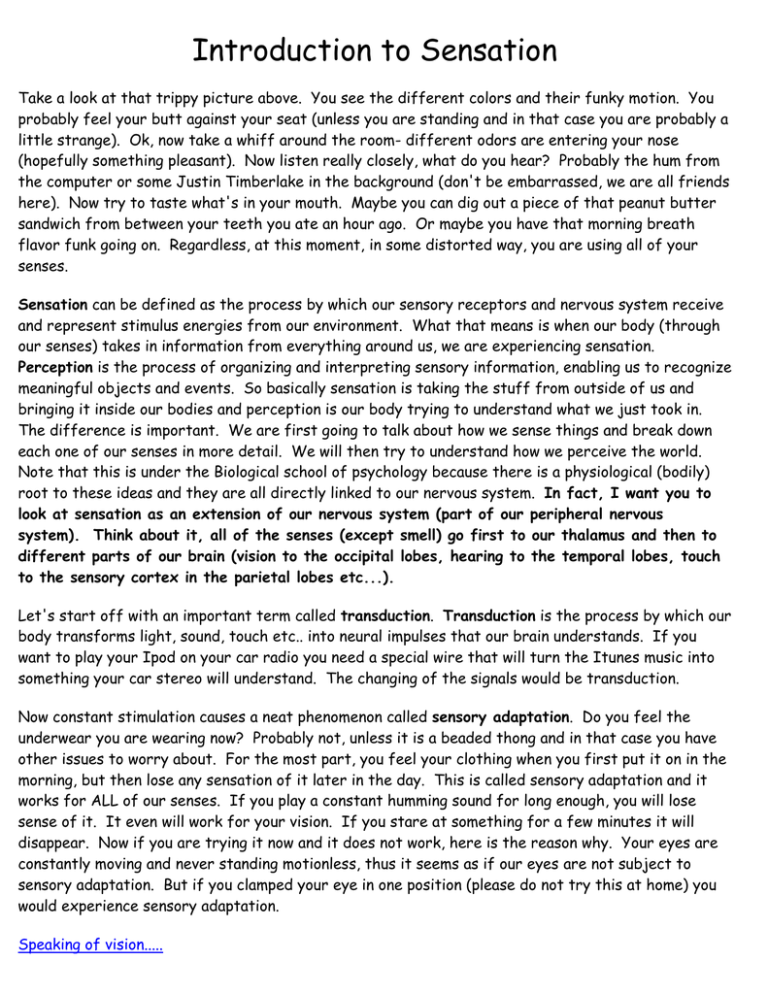
Introduction to Sensation Take a look at that trippy picture above. You see the different colors and their funky motion. You probably feel your butt against your seat (unless you are standing and in that case you are probably a little strange). Ok, now take a whiff around the room- different odors are entering your nose (hopefully something pleasant). Now listen really closely, what do you hear? Probably the hum from the computer or some Justin Timberlake in the background (don't be embarrassed, we are all friends here). Now try to taste what's in your mouth. Maybe you can dig out a piece of that peanut butter sandwich from between your teeth you ate an hour ago. Or maybe you have that morning breath flavor funk going on. Regardless, at this moment, in some distorted way, you are using all of your senses. Sensation can be defined as the process by which our sensory receptors and nervous system receive and represent stimulus energies from our environment. What that means is when our body (through our senses) takes in information from everything around us, we are experiencing sensation. Perception is the process of organizing and interpreting sensory information, enabling us to recognize meaningful objects and events. So basically sensation is taking the stuff from outside of us and bringing it inside our bodies and perception is our body trying to understand what we just took in. The difference is important. We are first going to talk about how we sense things and break down each one of our senses in more detail. We will then try to understand how we perceive the world. Note that this is under the Biological school of psychology because there is a physiological (bodily) root to these ideas and they are all directly linked to our nervous system. In fact, I want you to look at sensation as an extension of our nervous system (part of our peripheral nervous system). Think about it, all of the senses (except smell) go first to our thalamus and then to different parts of our brain (vision to the occipital lobes, hearing to the temporal lobes, touch to the sensory cortex in the parietal lobes etc...). Let's start off with an important term called transduction. Transduction is the process by which our body transforms light, sound, touch etc.. into neural impulses that our brain understands. If you want to play your Ipod on your car radio you need a special wire that will turn the Itunes music into something your car stereo will understand. The changing of the signals would be transduction. Now constant stimulation causes a neat phenomenon called sensory adaptation. Do you feel the underwear you are wearing now? Probably not, unless it is a beaded thong and in that case you have other issues to worry about. For the most part, you feel your clothing when you first put it on in the morning, but then lose any sensation of it later in the day. This is called sensory adaptation and it works for ALL of our senses. If you play a constant humming sound for long enough, you will lose sense of it. It even will work for your vision. If you stare at something for a few minutes it will disappear. Now if you are trying it now and it does not work, here is the reason why. Your eyes are constantly moving and never standing motionless, thus it seems as if our eyes are not subject to sensory adaptation. But if you clamped your eye in one position (please do not try this at home) you would experience sensory adaptation. Speaking of vision..... Vision It may seem a little strange at first, but if you relax we will solve the puzzle of vision together. There are essentially four steps to vision. First we have to gather light into our eye. The light has to be channeled to the back of the eye. Transduction occurs. The information goes to our brain where we interpret it. Let's break down the 4 steps in a little more detail. Step One: Gathering Light For the AP it is important to understand that we only see a small fraction of the light spectrum. There are all kinds of light waves out there from long ones (infrared, microwaves or radio waves) to short ones (ultraviolet waves X-rays or even gamma waves (like what made the Hulk)). The light we can see is in what we call the visible light spectrum, and from shortest to longest goes violet, indigo, blue, green, yellow, orange and red. The height of the light wave determines it's intensity or brightness. While the length of the wave determines it's hue (color). So when we look at am object, these light waves enter our eye. Step Two: The Light Channeled within the Eye Once the light hits the eye it goes through a variety of structures. Take a look at the diagram below. The white part of our eye is called the cornea and basically protects and helps reflect light. The light goes through a hole in our eye called a pupil. The pupil is like the shutter on a camera, it opens or closes to let light in. The colored part of your eye is called the iris. The iris is a muscle that sole job is to open (dilate) or close (constrict) the pupil. So when the light goes through the pupil it first hits the lens. The lens is almost like a magnifying glass that reflects the light toward the back of our eye. The lens is constantly changing shape depending on whether we are looking at objects close to us or far away. The bending of the lens is called accommodation. When adults become old, their lens becomes rigid and they cannot reflect light properly to the back of their eye and need reading glasses. A really cool thing about the lens is that it reflects the light upside down and inverted toward the back of the eye (retina). Our brain must switch the image back right side up or we would have serious perception issues. The structure of the eye in Hebrew and Chinese (I think), in case this clears some things up for you. Step Three: Transduction Ok, so how does our eye turn the light into neural impulses so that our brain can understand. Most of the process occurs on the back of the eye called the retina. The retina is the most important part of our eye (it is often referred to as the brain of the eye). First, it is important to know that the retina is made up of several layers of cells and the light must pass through all of them to experience transduction (kind of like a water filtration process). The first layer of cells to be activated by light are called the rods and cones. Rods see only black and white and are spread throughout the outside of the retina. Cones see color and are located in the center of the retina known as the fovea. Rods out number cones by about 20 to 1. Since the cones are located in the fovea (in the center of the retina) we see color objects better if they are directly in front of us. Since rods are located on the periphery of the retina- we see black and white better in out peripheral vision. Ok- so the lens reflects the light back to the retina and it hits the rods and cones. If the rods and cones fire- they send the information to a second layer of cells called bipolar cells (you have to no nothing about these bipolar cells except they pass on the light to the next set of cells). So the bipolar cells give the information to a layer of cells called the ganglion cells. The axons of the ganglion cells make up our optic nerve which sends the information to the thalamus in our brain (where the optic nerve hits the retina is sometimes called our blind spot- I will show you how to find it in class). In case they ask (which I doubt they will- but if you are going for that 5 on the AP- the specific part on the thalamus that attaches to the optic nerve is called the lateral geniculate nucleus (LGN) and the area that the optic nerves crosses/intersects in our head (remember our cerebral cortex is contralateralized) is called the optic chiasm. This is a very simplified version of transduction in the eye- but I think it suites our purposes (suites our purposes- what an adult and nerdy thing to say). Step Four: Vision in the Brain We should already know from the brain chapter that the thalamus sends the visual information to the occipital lobe in the cerebral cortex. We interpret the image in the visual cortex in the occipital lobe. When you watch TV- you see all kinds of things at the same time. Let's say you are watching 24 and Jack Bauer is about to torture some random terrorist to save 145,000 people. You see Jack's shape, his motion, his colors and all kinds of other cool stuff about Jack at the same time. Scientists say that in our visual cortex we have specific cells that all have specific jobs. Some of these cells may just see shape. While other cells have the sole job to see motion. We call these types of cells feature detectors. OK- there is ONE last aspect left to cover about vision. That is how do we see color. There are two theories of color vision. Trichromatic theory: this theory is actually quite simple (so I like it more). It says that we have three types of cones in our retina. We have cones that detect red, blue and green and from a combination of those three colors we can see almost everything. Now you artists out there are now saying, dude- those are not primary colors!! The problem is that you are thinking in terms of paint, not light. Go check out a Projector TV and tell me what color the three bulbs are. The problem with this simple theory is that is does not do a good job explaining color blindness or afterimages. Ok - what is an afterimage. Stare at the red dot in the green square and count to forty. Then stare at the white square and tell me what you see (actually you really can't tell me, so tell yourself- or your mom). You should see a greenish/blue dot in a reddish/purple background. That is an afterimage. Opponent-Process Theory: this theory states we have three types of receptor cones and they each handle a pair of colors (red/green, yellow/blue, and black/white). If one sensor/color is firing, it slows the other from firing. The theory does a good job at explaining afterimages. Your cones, after firing red for awhile, will rest and fire the opposite green, when not being stimulated. It also explains color blindness well. Most people that have trouble seeing colors usually cannot see either tints of red/green or blue/yellow. Perception Perception is the way we interpret the information we sense. The way we interpret the world in many ways dictates our sense of reality. Even if our senses are keen (like superman on crack), if our perception is skewed we will not understand the information we sense. Lets first go over some basic definitions and rules of sensation and perception. Thresholds Thresholds are the idea that our senses have limits. First there is the absolute threshold, which is the smallest amount you can just sense something about half of the time. What that means is that if the guy sitting next to you in class farts, and you take a whiff and smell it, but the next whiff do not smell it, then kind of smell it again- the fart is at your absolute threshold for smell. If you can just barely hear a sound- then it is at your absolute threshold for sound. Get it? Another type of threshold is called the difference threshold (or just noticeable difference). The difference threshold the the smallest amount of change needed in a stimulus before we notice the change. Ok, picture this- you are watching TV (Family Guy or Gilmore Girls- take your pick) and your parents are singing Backstreet Boys in the next room. You grab the controller and raise the volume one bar, but you still can't hear Peter Griffin and his witty anti-Semitic rhetoric (note the sarcastic tone). That change in volume was under your difference threshold (or just notice difference). In fact, you need to raise the volume four bars until you can tell the difference in amplitude. So the difference threshold for your hearing is somewhere between the three and four bars on your TV. We measure the difference threshold by using something called Weber's Law. Weber's Law states that the change needed to notice a difference between two stimuli is proportional to the original intensity of the stimulus. The more intense the stimulus, the more it will need to change before we notice the difference. If you are lifting ten pounds, you only need a little more weight added on to notice the difference (1 pound to be exact). But if you were lifting 100 pounds, you will need more weight to notice the difference (10 pounds). For weight the proportion is 10% increase, hearing 5%, vision 8%. So is you see a light shining at 70 watts, you must add 8% more intensity to see an increase in brightness. Perceptual Theories There are several theories that psychologists have that show us how we perceive the world. These theories are not in opposition to each other (like McDonalds and Taco Bell- they are more like McDonalds and The Gap- just different). Signal Detection Theory: This theory examines how outside influences effect our perception. This theory attempts to predict what we will pay attention to among competing stimuli. For example, they believe that one's absolute threshold depends on your motivation to sense, tiredness, and a whole host of other issues. They question why a new mother will sleep through traffic but awaken upon hearing the smallest whimper from their newborn. Picture yourself at a noisy party, and someone says your name 10 feet away. You will probably notice that sound above all the others (called the cocktail party effect) because you are motivated to hear your own name. All of these factors (motivation, state of alertness, etc..) are called response criteria. For example, if I am really hungry for meat, I am more likely to smell a hamburger than if I was not. If I think I smell a hamburger, but it is not really there, that is called a false positive (perceiving stimuli that is not there). If a hamburger is grilling right in front of me but I fail to smell it, that is called a false negative (not perceiving a stimulus that is present). Which one is worse? Top-Down Processing: When we perceive the world through top-down processing we are using our experience to fill in the gaps in front of us. Take a look at the following sentence- I _ant t_ e_t s_om_ c_tt_n ca_dy. You probably just automatically filled in the gaps and assumed that I want cotton candy (who doesn't). You know how to read and at this point see sentences not as individual words, but as ideas. You look at the problem as use your experiences in reading to solve it. Piaget (remember him) would say that you are relying on your schemas to process the information. These schemas often cause us to form a perceptual set (a predisposition to perceive something in a certain way). For example, Beavis and Butthead have a well known perceptual set; sex. Every time someone in their word says the word "tool" or "hard", they see it as sexual. Their schemas for sex are so encompassing that they create this perceptual set so that everything in their lives is seen through the eyes of sexuality. In the 1970's, many parents were concerned about backmasking in music (when you play the music backwards, secret satanic messages are revealed). Now in reality, there is nothing but jumbled noise, but the parents created a perceptual set, expecting to hear devil messages, so what did they hear? What they expected. Bottom-Up Processing: This type of processing usually occurs when we are unfamiliar with an object. Instead of using our experience to decipher an object (like in top-down) we use the features of the object itself. We actually examine the object at its basic core structure. Try to picture a five year old who has just learned to read try to decipher I _ant t_ e_t s_om_ c_tt_n ca_dy. They would examine every line and curve because they do not have the experience to do what you or I would do. This type of processing is slower, but also prone to less errors than top-down. Visual Perception Psychologist love tackling issues dealing with how we see the world. They examine issues like the figure-ground relationship which deals with how we distinguish what objects in our vision do we want to examine (figure) and what parts are just background (ground). Above are two famous pictures that examine the figure-ground relationship. What is the figure in either picture and what is the ground? To the left is the vase the figure or ground? Maybe the two faces are the figure? On the right, you have to distinguish between the woman and the saxophone player. Which is the background and which is the figure? Gestalt Psychologists Gestalt psychologists were a group that explored some of the above issues. In particular they were concerned with how and why we GROUP objects together. They stated that humans can't help but perceive stimuli in groups rather than individual or isolated elements. They had five factors for how we group objects. 1. Proximity: Objects that are close together are more likely to be perceived as belonging in the same group. If you see two people walking down the hallway next to each other, you will probably perceive them as friends. 2. Similarity: Objects that are similar in appearance are more likely to be perceived as belonging to the same group. If there are a small group of Latinos in your class, you may think they all know each other because you view them as similar (you may not be right of course). 3. Continuity: Objects that form a continuous form (such as a trail or geometric figure) are more likely to be perceived as belonging to the same group. 4. Closure: Objects that make up a recognizable image are more likely to be perceived as belonging to the same group even if the image contains gaps that the mind needs to fill in. Just like top-down processing. Gestalt thinkers are obsessed with the notion that we group these objects together in our lives and create groups that are larger than the sum of their parts. If you asked me to sit down and write down all of the feeling that encapsulate the feeling of love I have for my sons, I may spend days writing. But even after I finished the list, it will NOT equal my feelings. My feelings of love (group) are larger than all the individual reasons I have to love. It's kinda cool when you think about it. Visual Constancy Remember, our eyes are like mirrors, reflecting information to the back of our retinas. Even though the object we are looking at may change on our retina, we still know the object itself has not changed. That sounds confusing but look at these concepts: Size Constancy: Objects that are closer to us produce bigger images on our retinas. For example, if Mario Lopez was standing 100 feet from you, he would produce a image on your retina. If he dances closer to you, his image on your retina will slowly increase. But you know that Mario (a.k.a. Slater) is not really growing. His size is kept constant in your mind, even though the picture on your retina changes in size. Shape Constancy: Objects viewed from different angles will produce different shapes on our retinas, but we know that the shape of the object remains constant. Take a look at the doors above. The one to the left looks like a rectangle, The one in the middle is shaped like a (what do you call it.....) parallelogram? The shape looks different in our retinas, but our mind maintains that the shape of the door remains a rectangle. Brightness Constancy: We perceive objects as being a constant color even as the light reflecting off the object changes. Kermit the frog is green in the daytime. As night comes he will look gray, or even black as the light fades. But we know that his color is always green even though it may not look like so in our retina. Depth Cues The concept of depth is one of the most studied aspects of perception. Imagine what the world would look like if we could not see depth (it would look 2 dimensional). Researcher E.J. Gibson conducted a very famous experiment called the visual cliff experiment to determine when humans are able to see depth. He placed an infant onto one side of a glass topped table that creates teh impression of a cliff. Actually, the glass extends across the entire table, so the baby cannot possible fall off. Gibson discovered that by the time the baby can crawl, it will not crawl across the glass table, showing us that depth perception does exist at young ages. The general consensus is that babies develop depth perception at around three months of age. The way babies (and adults) understand depth is by using a bunch of tricks that are called monocular and binocular cues. Monocular Cues: Monocular cues are tricks that we (and artists who draw alot) use to judge depth perception. What makes them monocular cues is that you need only one eye to use them. So if you lost your eye in a tragic ping pong accident, the following cues would still be at your disposal to see depth. Interposition: If Justin Timberlake is standing in front of me and blocking me from looking at Jessica Alba, I am going to assume Justin is closer to me. So if something is blocking something else, the thing being blocked is farther away- kind of in your face obvious. Texture Gradient: Objects look smoother if they are farther away and rougher if they are closer. To look at Beyonce's face from thirty feet and it will look smooth as pudding. But get right up on her face and you will see crevices, bumps and imperfections all over. Smooth=far away Rough=closer. Relative Size: If we know that two objects are around the same size and one looks alot bigger in our visual filed, you are going to assume it is bigger. The Olsen twins are hanging out at your crib. Ashley looks huge and Mary-Kate looks really small. You are going to assume that MaryKate is farther away from you than Ashley or has some type of eating disorder- which is more likely? Linear perspective: Parallel lines look like the are converging over a distance. Binocular Cues: Binocular cues are tricks we use to see depth using BOTH your eyes. So if you are missing an eye, these will do you no good. Retinal Disparity: We have two eyes, so the brain gets two images. The more similar the images are between the two eyes, your brain will assume the object is farther away. The more of a difference the images are between the eyes, you brain will assume the object is closer. I will explain in class, first one that reminds me gets 5 points on the Perception Quiz. Convergence: As an object comes closer to us, our eye muscles must strain to stay focused on the object. The brain receives feedback from the muscles controlling eye movements and knows that the more the eye converges, the closer the object must be. Culture and Perception It is true that our culture does effect the way we perceive the world. Some cultures, for example, do not use certain monocular cues (like linear perceptive). Take a look at the figure below and tell me which line is longer. People in western societies tend to perceive the first line as being longer even though they are the same length. If you come from a culture that does not use right angles (non carpentered cultures) you would not be fooled by such an illusion.


